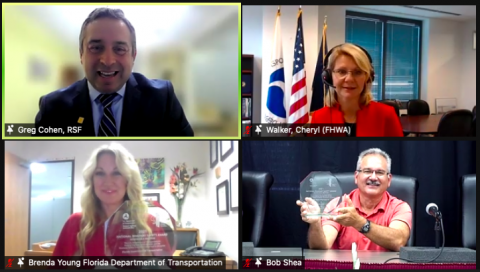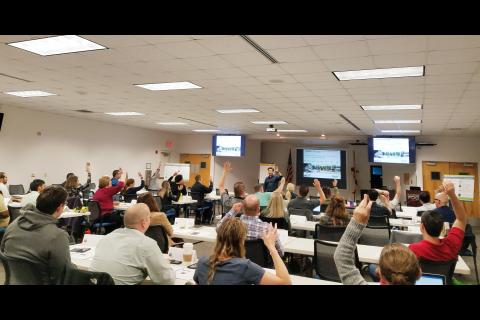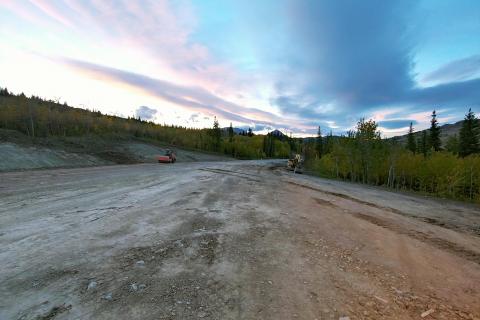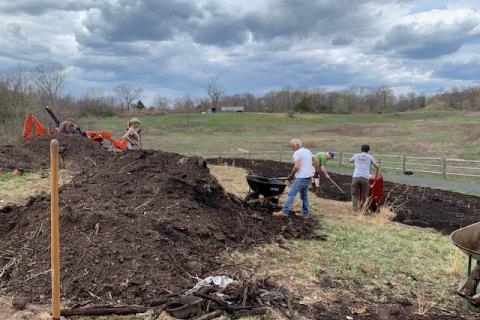
Honorable Mentions are given at the discretion of the judging panel when there is broad agreement that a particular project merits inclusion in the Noteworthy Practices Guide for the benefit of other professionals and agencies. Although Honorable Mentions are not necessarily named in every Awards cycle, the outstanding 2021 applicant pool yielded three projects earning this distinction.
FDOT Local Technical Assistance Program

Local transportation agencies are vital in the effort to improve roadway safety in Florida, because they design, operate, and maintain their own roadways and assist the Florida Department of Transportation (FDOT) toward achieving our collective target of zero serious injuries and fatalities. FDOT uses its Florida Local Technical Assistance Program (LTAP) to improve the skills and increase the knowledge of local and transportation workforces on roadway safety via training and technical assistance.
FDOT encountered numerous challenges, including limited options for no-cost safety-related trainings for employees of Florida local transportation agencies, and low attendance at the trainings that were available. The arrival of the COVID-19 pandemic in early 2020 only exacerbated FDOT’s concerns, as in-person learning was severely disrupted.
To address the overall problems on safety-related training, Florida LTAP Center housed at Center for Urban Transportation Research developed and implemented its cost-efficient approaches to achieve no-cost safety-related trainings to all attendees, and used innovative approaches to increase attendance of these trainings. Florida LTAP also successfully transitioned from in-person training to online webinars to effectively address the significant impacts of the COVID-19 outbreak.
Within three years, over 50 new courses were added to LTAP offerings and training attendance increased substantially. The current Florida LTAP virtual safety-related trainings attract an impressive average of 434 transportation professional attendees per training session.
Project Contact: Brenda Young, State Safety Engineer; brenda.young@dot.state.fl.us
Montana Department of Transportation's North of Kiowa North

US Highway 89 west of Browning, MT traverses the Blackfeet Indian Reservation and provides a key entrance to Glacier National Park, which typically sees 3 million visitors each year. The route, originally built in 1927, was narrow with sharp curves, few turnouts and heavy tourist traffic. To improve roadway safety and traffic flow while minimizing impacts to numerous Blackfeet cultural sites, adjacent wetlands, and area wildlife, the Montana Department of Transportation (MDT) performed major road improvements along a 5.8-mile stretch. These included reconstruction of 21 substandard horizontal curves, shoulder widening, and provision of edge line rumble strips.
The project implemented many innovative engineering concepts including snow storage design, geotechnical slope stabilization and armoring, and strategically located vehicle pullouts to accommodate motorists wishing to pullover to observe the natural landscapes, vistas, and cultural sites. Motorcycle enthusiasts specifically requested the perpetuation of a curvilinear alignment to maintain riding pleasure, which was achieved while still providing curves that are much safer, meet full design standards, and accommodate the RVs and other large vehicles that also use the corridor. Moreover, existing shoulder widths were zero to one feet, while the new roadway provides consistent 6-foot shoulders with edge line rumble strips. Each of these safety improvements reduces crashes; combined, they have a more comprehensive safety result. Using the Highway Safety Manual crash predictive method for rural, two-lane, two-way roads, the new alignment is predicted to see a crash reduction of 85.9 percent.
Located entirely on the Blackfeet Nation Reservation, this vital project improves roadway safety and traffic flow while protecting and enhancing the cultural resources and economic opportunities for the local population. The design team worked closely with the Blackfeet Cultural Department to identify and locate the culturally significant sites including burial grounds, cloth offering sites, teepee rings, and cairns. Additional benefits include protection of the natural environment, facilitated passage of wildlife, and decreased future maintenance costs from winter snow removal operations.
Project Contact: Jim Wingerter, Great Falls District Administrator; jwingerter@mt.gov
Making Complete Streets in Portland, CT

Located in central Connecticut and responsible for 63 miles of roadway, the Town of Portland is a small community of under 10,000 residents that faced serious safety concerns regarding vehicle speeds and limited opportunities for safe walking and cycling. To address these concerns, a grassroots Complete Streets Group (CSG) wrote the Complete Streets Policy and got the Town’s elected leaders to formally adopt it in 2016. The CSG then started working with Public Works and the Town Engineer to plan, design, and construct safety improvements.
Priority Goals were identified, including 1) Work with partners to reduce speeds; 2) Establish healthy lifestyle choices by providing safe walking and cycling options; 3) Promote a Complete Streets Culture through education and events such as bike rides and trail walks; 4) Identify gaps in sidewalks, roads and trails, with the goal of enabling multimodal safe travel to schools, residences, businesses and recreation opportunities; and 5) Implement safety improvements based on the Complete Streets Policy.
In 2016, a State grant was awarded to design and engineer the 2.38-mile Air Line Trail, a major component of the 111-mile Central CT Loop Trail. The Air Line Trail was completed in 2018, and hiking is up by 3,000 users per week. Additionally, a municipal bond was issued in 2018 to fund repairs to two miles of sidewalks and a 0.5-mile road re-build. These safety improvements were engineered, designed, and completed in 2020, the same year a State Connectivity Grant was awarded to repair sidewalks along State-owned roadways. This work has also been completed.
Cycling has increased in town, as well, with the creation and signage of Safe Bike Routes and hosting of bike events by CSG. After a speed study, Portland installed digital speed signs on roads with excessive speeding, and these have contributed to overall speed reductions in town. The success of these signs in slowing vehicles – particularly near schools – has led the University of Connecticut to award the town two additional signs that will be installed in other areas of town with speeding problems. Other forthcoming work will include sidewalk improvements, provision of a new bus shelter, and other connectivity efforts in an underserved low-income area of town.
Project Contact: Robert Shea, Director of Public Works; rshea@portlandct.org
